Ultimate Guide to Exercises for Lumbar Herniated Disc Relief 2
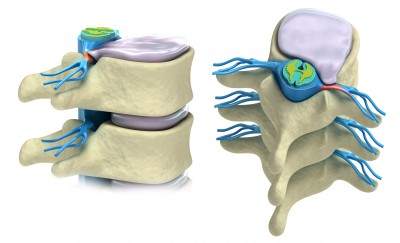
Did you find our previous article, “Disc Herniation Part 1,” helpful but are still battling discomfort? Are you eager to discover exercises that can effectively reposition your herniated disc and enhance your well-being? You’re in the right place.
In this comprehensive guide, we’ll cover:
- Effective Exercises for Repositioning a Herniated Disc: Learn the top movements to gently coax your disc back into alignment, reducing pain and improving mobility.
- Stabilization Techniques to Prevent Disc Displacement: Discover exercises that strengthen your core and back, ensuring your discs stay in place.
Understanding Lumbar Disc Herniation:
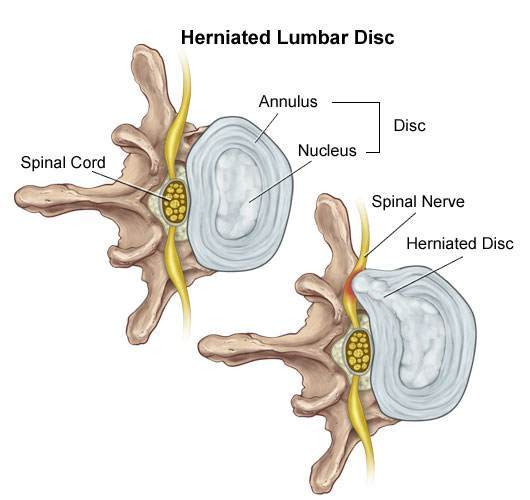
A herniated disc occurs when the disc’s nucleus breaks through the annulus, as shown in the illustration from neurosciences.beaumont.edu. But what triggers this displacement? The primary culprit is forward bending, which compresses the disc (think of it as a jelly-filled doughnut) and can lead to the annulus fracturing, allowing the nucleus to protrude and press against nerves.
Why Does it Hurt?
The disc’s exterior is tough cartilage, while its interior is softer, akin to mucus. Applying pressure on one side forces the inner material to the opposite side, similar to squeezing a doughnut. When a herniated disc or inflammation puts pressure on a nerve, pain ensues. The key to relief is applying counterpressure to reposition the disc.
For a deeper dive into herniated discs, refer to “Disc Herniation Part 1: Best Self-Treatments for Lumbar Disc Herniation.“
How to Apply Counterpressure:
The strategy involves bending your spine backwards or into the extension to shift the disc away from the nerve.
Exercises to Reposition a Herniated Disc: Note of Caution:
Initially, these exercises might intensify your pain slightly. If pain significantly worsens or radiates further down your leg during these exercises, cease immediately and consult a professional.
Exercises for Lumbar Herniated Disc
#1 Prone Lying Lumbar Herniated Disc
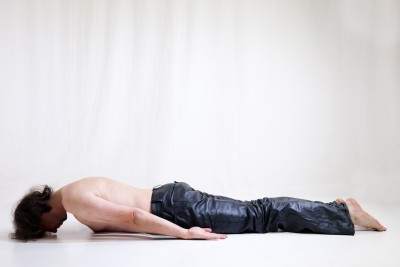
- Lie face down or prone in bed with your elbows tucked in under your side:
- As soon as you get up in the morning you should lie prone (face down). By getting in this position, your lower back becomes more arched, or as doctors say, you increase your lordosis.
- The increased lordosis pushes on the back of the disc helping to bring the nucleus forward into the correct position.
#2 Sphinx pose in Yoga For Lumbar Herniated Disc
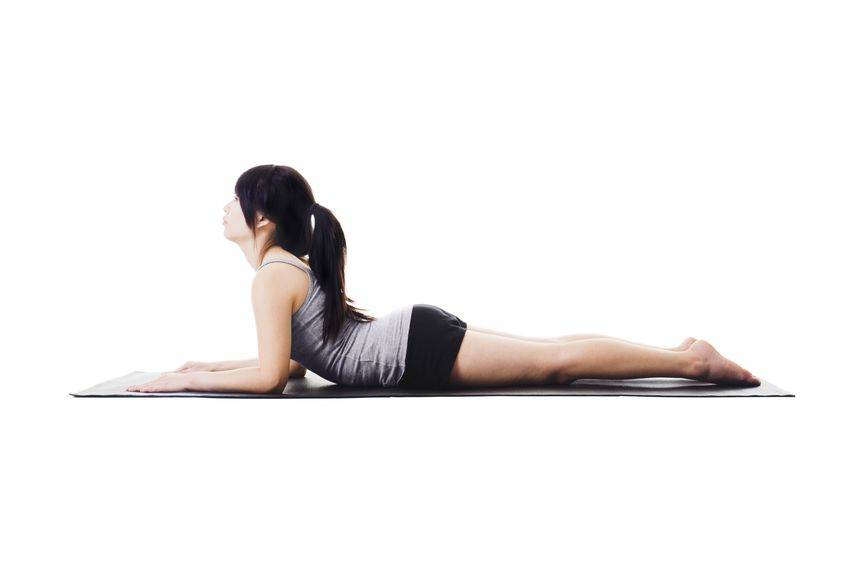
- Get into the prone position lying down on your stomach.
- Next, get on your elbows. If you have a hard time with this position go back into the prone lying position.
- Do these exercises hold each time for 1-2 seconds 6-8 times per set? This exercise can be repeated every two hours throughout the day.
Asses yourself. If the pain has decreased or the pain has moved away from the leg or thigh and into the hip or buttock, this is an improvement. Even if the pain is increased in the back but relieved in the leg this is an improvement and a green light that you should continue this exercise. You also get a green light if there is no difference at all.
- If your self-assessment gives you the green light, move on to the Cobra exercises just below.
- If your thigh or leg pain is worse, then stop right away.
- If your lower back, thighs and legs are the same you get a green light, so move on to the Cobra exercises.
#3 Cobras For Lumbar Herniated Disc
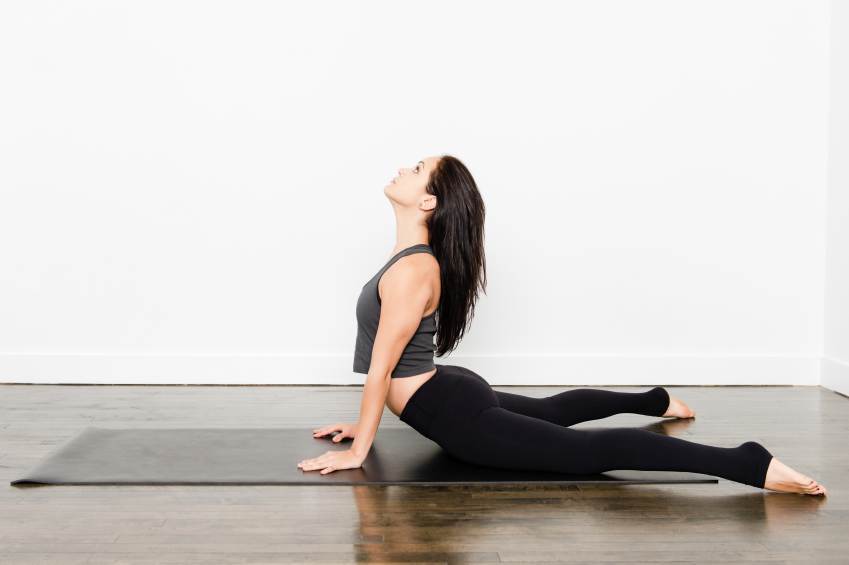
- Lie down face down with your hands underneath your shoulders.
- Push up from as high as you can until your lower back stops you or your elbows are straight.
- The pelvis should still be on the floor and the lower back muscles relaxed.
- Do these exercises hold each time for 1-2 seconds 6-8 times per set? This exercise can be repeated every two hours throughout the day.
Asses yourself. If the pain has decreased or the pain has moved away from the leg or thigh and into the hip or buttock, this is an improvement. Even if the pain is increased in the back but relieved in the leg this is an improvement and a green light that you should continue this exercise. If your thigh or leg pain is worse, then stop right away.
#4 Standing Extensions Lumbar Herniated Disc
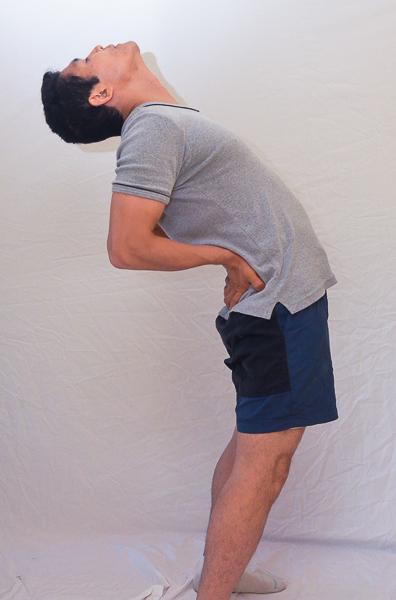
- Stand straight and put your hands behind your hips with your fingers facing down.
- Push your hands into your pelvis so that your lower back arches.
- Don’t use your lower back muscles
- These exercises can be done 6-8 times for 1-2 seconds. This exercise can be repeated every two hours throughout the day.
Stabilization Exercises: Prevent Your Disc From Coming Out By Having A Stable Spine.
#1 Cat-Camel or Cat-Camel For Herniated Disc
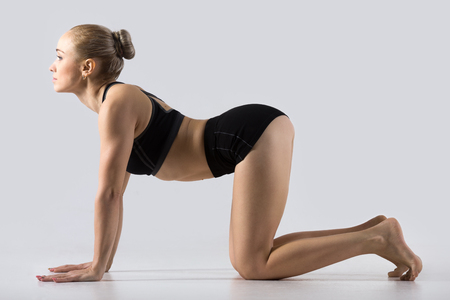
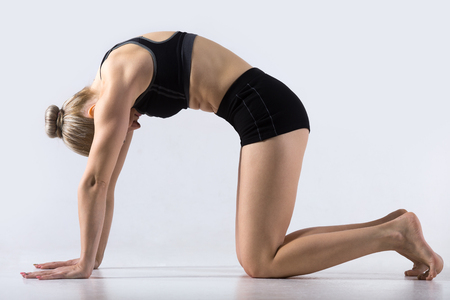
- On all fours with your knees under your hips and hands under your shoulders.
- Inhale and let your belly fall downwards toward the floor as you look up toward the ceiling for 2 seconds.
- Exhale and arch your back up as far as it will go or until you feel pain. You should not feel pain with this exercise, otherwise you are going too high.
- At the same time bend your neck forward and look toward your navel.
#2 Curl-Ups
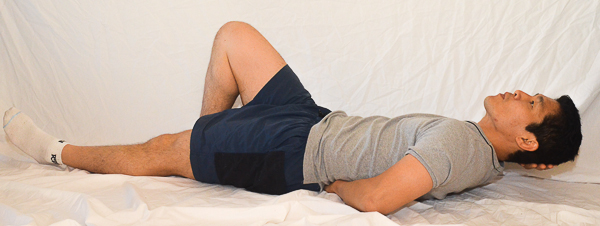
- To start, one foot is bent and the other is straight.
- One forearm goes under the arch of your lower back to support it.
- The other arm is supporting your head.
- Your head and neck come up as one block until your shoulder blades clear the floor.
- Do three sets of 5 working your way up to 10. If it’s easy, then hold for a couple of breaths.
#3 Squats
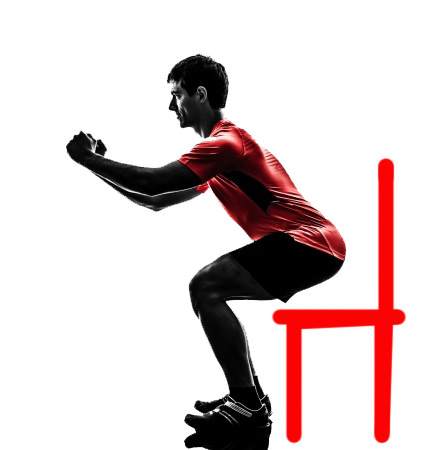
- Stand in front of a chair as if you are going to sit on it.
- Stand with your feet facing slightly more outward than your knee.
- Make sure your butt comes out, and keep lowering your butt until you touch the chair.
- Practice 3 sets of 10.
#4 Bird Dog
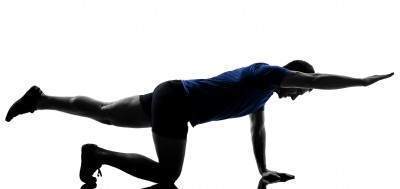
- Get into a crawling position with your hands and feet shoulder-width apart.
- Harden your core by contracting your abs and lower back. This is called bracing.
- Lift your arm first. If this is easy, then lift your leg only. If that is easy, then lift the opposite legs and arms, for example, right leg, and left arm.
- Want to make it tougher? Try lifting an arm and leg on the same side.
- 3 sets of 10. If you are shaking a little or cannot balance quite right, you’re doing the right exercise for you, i.e. lifting just the leg or arm might be easy, but lifting opposite arms and legs might put you off-balance a bit. Make sure you are stable before going to the advanced bird dog.
Tell us what you think in the comments below and like us on Facebook. This Toronto Downtown Chiropractor will answer all questions in the comments section. Let us know your vote for the best Toronto chiropractor in the comments section.
References
1. J Med Genet 2002;39:387-390 doi:10.1136/jmg.39.6.387


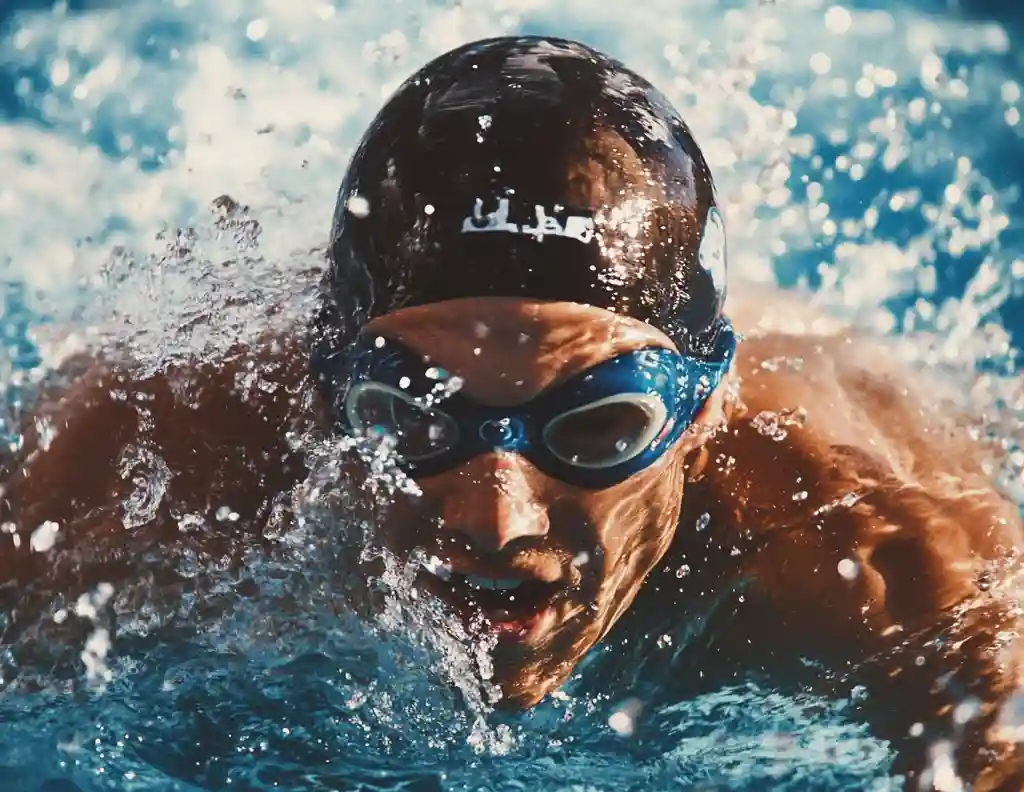

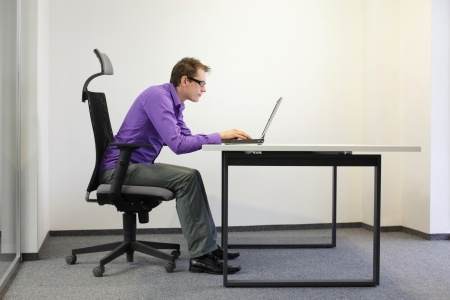
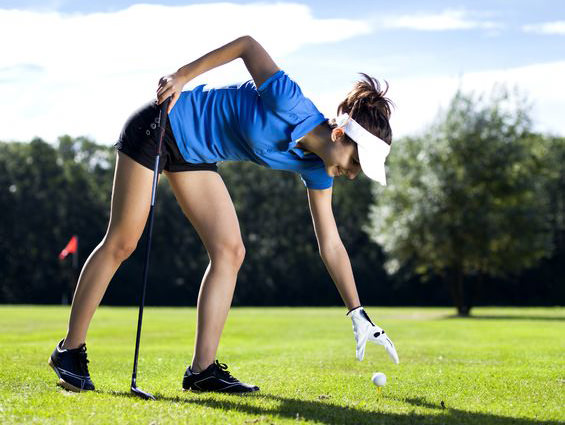
Hello Sir. I am 32 year old ,my MRI result shows 1)Diffuse disc bulge at L4-L5,L5-S1 causing indentation on thecal sac bilateral moderate to severe lateral recess narrow impinging on exiting and traversing nerve roots.
2) Diffuse disc bulge at L3-L4 causing indentation on thecal sac bilateral mild lateral recess narrowing.
Please advise on above MRI report to recover my disc and what I have to take the precautions in order to avoid more complications in future.
With many Thanks.
Dear Dr.Ken
I am 24 year old male. A side from having some back problems over the last few years, I have always been very fit and healthy. Competing in sports, running, swimming and regularly attending the gym.
12 months ago i pulled my lower back whilst lifting weights, the pain was intense and i nearly fainted. I have only recently had an MRI scan, the results showed that my 3rd, 4th and 5th Lumbar Vertebrae are all suffering from wear and tear (which i have been told by the doctor is strange for someone my age), as a result of the wear and tear, 3 discs are also protruding an pressing on some nerves. The doctor told me that it looks like this problem has been going on for years!
The pain would be 10/10 at the right side of my lower back, continuing with this pain down to my right hamstring. I would also get a burning sensation and tingling right down my leg into my foot and big toe. Ive been taking a number of medications for nerves and pain, this has helped the pain subside over recent weeks.
However, i have re-started doing some light weight training and core work recently. Although it does not hurt me while i am doing the training, it seems to have aggravated something and i can feel the same old pain and burning/tingling sensations days after.
My questions are:
1. Why would I have such a bad back (worn down vertebrae) at this young age?
2. Is core work (bending, extensions, planks etc) good or bad for my condition?
3. Is weight training good or bad for my condition? (This is a big part of my life).
Kind Regards,
Tony
Dear Dr.Ken
I really thank you a lot for your valuable “body empowerment” subject from which I have learned a lot about how I should manage my physical movements and improve our body’s mechanics in a better way.
I have one question to ask you. It was on 20 September 2013 that I had the first very painful shooting pain that almost broke my lowerback when I was watching a TV and slowly walking around my house. At that moment I was not doing something different or challenging like lifting some heavy things or prolonged forward bending for doing something on ground or lower levels, I didn’t even fall down and nothing different happened to me. That pain was really the most shocking one that I have ever experienced in my life time. The pain was so intense around my lowerback and butts that I couldn’t even manage to walk single pace and sit or sleep for a while.
After like 2 hours of getting that pain I went to hospital and had X-ray check. The X-ray was taken from three directions (lower back and sideways), however no signs of problems were detected and the physician simply gave me painkiller stating that this might be a transient pain that may go away after one or two days.
Thenafter, I started taking the painkiller and got relieved of the intense pain for atleast two days after which I went to a diagnosis center for MRI check where I had MRI for lowerlumbar where I had intense pain. The MRI result has shown the following:
-All disc and vertebrae are normal except mild herniation of L4-5 disc
-It is broad based posterior disk protrusion with mild spinal canal stenosis.
After this I went to a chiropractor clinic, had physiotherapy for two weeks, and then got some improvements except feeling of some pains and discomfort at lower back while sitting for over 30minutes and driving for more than 30minutes. The chiropractor had given me stretch and core exercises that I have to do every day morning and night. I have been strictly doing those exercises upto now. Generally I am in good condition and do not have too much pain that holds me from doing my professional job which mainly requires sitting in office with computers and going out for field works occasionally like every one month. However the minor and almost continuous small pain and discomfort at lowerback especially while sitting in office and minor numbness (in fact without pain) of my leg are giving inconvenience in my daily lives. I am also having fast walking every day for a distance of 4 to 5km without having any pain to my lowerback or legs. I am also doing your recommended exercises everyday morning and night.
Dr.Ken, would you please recommend me how I can get improvement in my lowerback and slight numbness of both legs while sitting. I am thinking of having some sessions of spinal decompression using mechanical traction machine, if it may it help my case? Please advise!
With best wishes and great thanks to your unlimited contribution to the people at large.
Amaj
I have two disc herniations as per MRI..L4-L5 (4mm) with slight thecal impression and L5-S1(5mm) with dural compression.Initially I had periods in which I could not walk with pain. Pain especially aggravated with Sitting and BLT(Bending, Lifting and Twisting) My pain is at the lower back region only now after 8 weeks. ROM has improved. Sitting is still a problem. So is driving. What is causing the sitting issues? If I do not have any nerve problem? Can the dural/thecal impression cause local pain? I am also doing the McKenzie excercises and also walking. I also try to maintain lordosis when sitting. How do I resolve my sitting disability?. Is it the last one to resolve?
In your experience/knowlege do these help to resolve my sitting disability?
1 Chiropractic Mainiplation
2 Spinal Decompression
3 Percutaneous disk decompression performed in Europe for contained disk protusions like Ozone Therapy and Nucleoplasty which keep the annulus intact.
Author
Thanks for your comment Ban. The key is that sitting increases pressure in the lower back. Most MRI are take lying down. So your MRI says that you have “slight thecal impression” on the thecal sac with dural compression. Well when you sit the pressure in increases so you would have moderate pressure of your thecal sac with sitting, lifting and twisting. So you do have a nerve problem when you sit.
Chiropractic and spinal decompression or traction are both helpful for disc herniations. Percutaneous disc decompression doesn’t have much research to back it up but may be proven to work in the future.
Hope that helps your disc herniation.
Thanks for you response Ban..Help like your websites are keeping more of us educated and mobile. Thanks for your help and education you are providing to the public. You are truly making a difference!
Just a quick follow-up one of the sugeons I visited said Degenerative Disc Disease is the primary diagnosis and the herniations are the consequnce of that.
But you also hear from studies that Degenerative disc disease and consequently herniations are like aging and greying of the hair/ wrinkes in the face. Then they also claim that many non sympomatic people have these.
Then I would ask Why are n’t millions of seniors not having serious problems if all of them have degenerative disc and most probably their lumbar discs are degenerated by their age.
Is their something that makes these Degenerative disc more sympotamtic in younger people than older people?. In other why do some people feel these when many dont.
Author
Thanks for the follow-up questions. Lots of good studies have found that there is almost no correlation to pain and the degree of disc herniation and also the degree of degenerative disc disease. On the following link I explain this fact. https://www.bodiempowerment.com/mri-ct-scan-x-rays/
When the discs herniations are really big there is a better correlation but some people can have the most serious disc herniation called a disc sequestration and still have no pain or any symptoms. That is why about 1/2 of disc surgeries fail for the lower back.
Hi Ken,
I recently got my Sacrum adjusted. I am wondering if there are any exercises for the sacrum like walking or anything to ensure it says aligned.
Do I need ti wait for sometime for the sacrum to solidify or can I do some backward bend. I have L4/L5 herniation as well. I am severely restricted in mobility as well. There are painful spots on the sides of my legs and sleeping on the back sends pricks and pointed pain on the sides and sometimes calves.
Please let me know if I should be doing something specific. I am going to a Chiropractor and the adjustments keep repeating for e.g. 2 weeks ago the sacrum was aligned followed by hips and the SI joint and after 2 weeks we are back to sacrum adjustment. I want to know why it is taking repeated attempts to fix the same spot. I am cautious in walking, lying down, standing all the time and no bending and sitting.
Please help me as I am quite discouraged by the progress
Author
Thanks for your question Sara. The question is if you are actually getting better Sara. You should take a test like sitting down and doing a straight leg raise eg. http://www.buzzle.com/articles/leg-exercises-for-bad-knees.html or a lying on your back straight leg raise before and after your adjustment or your low back range of motion. If you improved a little and it remains that way than that’s OK if the chiropractor is adjusting you in the same spot. Improvements don’t always go up in a straight line. It often goes up and down but as long as the trend is up towards relieving your pain than I would not be worried.
If you are finding that there is no difference before and after the treatment and the chiropractor is doing the same thing than there is a problem. The chiropractor should change the approach. Either with a new approach like acupuncture, etc…
Hope that helps your sacrum.
Dear Sir,
I am 28 years old having two kids through c- section. I had spinal anaesthesia both the times. Gap between two c section is less than 2 years.
I am working in IT for the past 7 years. I never care about my posture. Also sit prolongedly.
When I was carrying my second kid ( 2.5 years back) I got pain in gluteus muscle. Pain comes and goes. Recently my pain was increased and comes frequently. Also got shooting pain in entire left leg. Then took MRI and found that there is a bulge in L4 L5 disc and it is hitting the nerve in left side L5 root. After that consulted with many ortho and they suggested for surgery. I never want to go for surgery. So I thought of trying conservative treatments like physiotherapy and exercise. Please let me know if I could do these exercise and disc bulge will get recovered. Thanks a lot.
Author
Thanks for your question Banu. The exercises will likely help in your case. You will see if you are getting better if the pain goes from lower in the leg to higher up the leg. You are getting worse if the pain goes further down the leg. The exercises are not for you if you get sharp pain while doing the exercises or pain that increases more as you do more of the exercises and if you get pain for more than 1/2 hour after the exercises.
Hope that helps your disc herniation.
Dear Doc,
I am a regular reader of your page. I had an MRI Scan in 2013 because of severe ongoing pain for the last 3 years. The results showed that the spinal canal on the whole is congenitally narrow. At L4/l5 level, posterior disc protrusion is seen causing significant identation on the sac and narrowing of the spinal canal as well as likely to be compressing both L5 roots. Th rest of the lumbar vertebrae and disc spaces appear normal. All neural foramina and exiting nerves appear clear. No significant facet joint degenerative changes seen.
I was then referred to the Physiotherapist but that didn’t help a lot. Five years later, I am still suffering from pain in my lower back. I can’t do much exercise nor running. I always feel stiff and tight above my posterior. When I urinate, I feel pain on my right posterior. However, there is no pain in my legs.
Since I’ve read your articles, I’ve been doing some of the exercises you recommend. I find them very helpful. I would like to know if there is anything in particular that I need to be doing in order to reduce the pain.
Many thanks for all your help.
Ozgur
Author
Thanks for your questions Ozgur. As long as you find the exercises helpful just keep doing the exercises. With congential narrowing it makes treatment very tough. The exercises may only help but never get rid of the pain.
Hope that helps your disc protrusion.
Hi Doc, I received MRI results with foraminal and lateral recess herniations in L3/4 and L 4/5, measuring “3x13mm” and “4x30mm” respectively. I am confused by the measurement notations: do these herniations fall under the category of acute, mild or severe?
The next available orthopedic consult is in 4mo. I would like to try your recommended exercises meanwhile. For the Cobra and Sphinx / McKenzie, do I keep my back and abdominal muscles engaged or relaxed while stretching? Is the goal of the stretch passive or active movement in the lumbar?
Thank you for the informative blog!
Author
Thanks for your question Hannah. First the measurements mean that you have a disc that is sticking out 3mm at L34 that is 13 mm wide. So at L45 the idsc is sticking out 4mm more than it should and it is 30 mm wide. This means you have a mild disc bulge, although that doesn’t correlate necessarily with pain. This means that you are not a surgical candidate for microdiscectomy surgery.
As for the Cobra just relax your abs this is passive and meant to put the disc back into place.
Hope that helps your disc bulge.
Hi Ken, I’ve been suffering from sciatica for 6 mos now. The symptoms have shifted at times,I was mainly getting buttock pain, but now primarily in the hip area and a stabbing pain that comes and goes in the calf, and sometimes groin pain. I’ve had PT and have been seeing a chiropractor. My chiropractor had though at first that the SI joint was the cause. I sit most of the day at a desk. My MRI impression shows L2-L3: Central annular fissure with 2mm broad=based central disc protrusion. Central canal and foramine remain patent.
L4-L5 5mm focal right paracentral disc protrusion. Mild narrowing of right L4 nerve root foramen. Right lateral recess stenosis.
L5-S1: No disc herniation. Central canal and foramina patent
I’ve done alot of exercising on my own, mainly focusing on prone press ups. I’ve had one very knowledgeble physician who is a freind tell me that these findings were pretty minor and time will heal me. NSAIDS have been very helpful but I don’t want to keep taking them. I’ve made an appt with a pain management specialist. I’m a little leary of the epidural, but I’ve read that they can diagnose if the SI joint is the main problem. In the mean time, which exercises should I focus on? Can doing to many prone press ups hurt? Does the MRI findings look serious enough for a possible epidural, which I would like to avoid. One other thing, the pain is exclusively on the right side and laying on my left side usually relieves most of the pain. I’d appreciate any of your thoughts, Thanks very much
Author
Thanks for your question Gary. The lateral stenosis at L45 can put pressure on your nerve and cause pain going down the leg. SI pain rarely if never goes down to the calf. I would do the exercises in this article to see if they can help you. If they do surely you don’t have a SI problem as the exercises here do nothing for an SI.
Hope that helps your disc herniation with stenosis.
Hie doc. About a month ago i had a sort of constant cramp at the back of my right knee with numbness on my right foot. This was followed by almost continous spasims on my right buttock for 2days. I was able to walk but limping. 2weeks ago i felt pain on my right leg when walking. The progressed from my lower back to my right buttock right down thru the back of my right leg to my foot. I resorted to crutch so that i go to the hospital. They said i had a herniated disk and needed bed rest for six weeks and they gave me a cocktail of tablets. The doc diagonised me with the straight leg test. When i use the crutches my right leg feels heavy and my lower back pains. Im stil bed resting i only go to the loo. Should i exersise or leave the crutches? Please help.
Zimbabwean
Author
Thanks for your question Simon all the way from Zimbabwe. You should not do any bed rest. if the diagnosis is correct. It just makes the disc larger and when you get up to walk around even more painful. In your case I would get an second opinion from someone that will do a neurological exam. They should check your reflexes, sensitivity and muscle strength to determine which nerve is affected. You can also do the exercises in this article.
Hope that helps your disc herniation.
Thanking u in advance doctor.
I am suffering from pain almost from 3 months. This pain i got wen i was working out in gym. My pain is in lowerback it radiates towards front of my right hip and pain reaches towards right leg. I feel numbness in right leg and getting nerves tight
L3-L4 Diffuse posterior bulge with posterocentral broad based prostrusion. Compression of the thesal sac and bilateral traversing L4 nerve roots.
L4-L5 Mild diffuse posterior bulge indents the thesal sac without neural compression.
Author
Thanks for your question Elia. When you have two levels of compression it makes the problem more serious. I would try the exercises but I would consider getting professional help at the same time as you have a more complicated problem as it will likely last longer and have more lingering effects.
Hope that helps your disc protrusion.
Good Morning Dr. Ken,
thank you so much for these incredibly helpful articles. It’s like you wrote them just for me. I am 42 yrs old and have been doing Crossfit for the last 3 years. This is, by far, the fittest I’ve been all my life. About 2 months ago, I went on day-long bike ride with an ill-fitted ‘cruiser’ bike I had rented on vacation. I have been having mild intermittent problems with my lower back since (ugh!). Last Monday, it appears one small reach ‘broke the camels back’. I felt a slight discomfort but the next morning I woke up with an appreciable amount of pain in my lower back, hip and thigh. I had a quick check up at a walk in clinic and they offered muscle relaxants and pain meds – neither of which I was excited about. I just wanted it to get better! I came across your articles – thank you, thank you, thank you – since, I have been religious about not bending forward, keeping my lumbar curve and not sitting for prolonged periods. The manner in which I set myself up to sleep is nothing short of embarrassing, but I’m gonna do whatever needs doing to get back to full mom duties – I’m walking around the house like I have a book on my head. I apologize for the long preamble… my question is this: I’m mindful of not upsetting my forward progress and I’m doing the exercises you recommend. When can I get back to the Crossfit-like core exercises (like Toes-to-Bar, and GHD sit-ups) without wrecking my progress? Are we talking weeks? Never?… (please don’t say never!) Thank you for any additional light you can shed on this. Have a great day!
Author
Thanks for your question Helen. GHD sit-ups are great to increase ab strength. If you have a disc problem you need to modify them. Just extend right back like you normally do and go to horizontal. As for Toe to the bar. When you are better you can do them again. I do them myself. Don’t get too hung-up that that is the only way that you can improve your improve your abs.
Hope that helps your disc herniation.
Hi Dr. I have a protusion disc L5S1. The same has DDD also….and on the last two months I have had two strong back pain episodes. I like very much to run and swim but after the last one I stop to do these exercises…which are making me sad…any advices? Thank you.
Author
Thanks for your comment Fabiano. You should try to do the exercises here first. Remember a disc protrusion is simply is not as bad as the next stage the extrusion and the next stage after that which is an disc sequestration. You should be able to do the exercises just fine. If your pain starts going further down the leg than you should stop. You should also stop if you get sharp pain or increasing pain.
Hope that helps your disc herniation.
At 85 years of age, I have been playing golf twice a week and hitting range balls at least three times a week for about an hour each time. A recent bout with sciatica in my right leg has brought my golf to a halt. The sciatica began within days after I started lifting an empty 20 pound wheelchair with my right arm then pushing it with a load of about 125 pounds for and hour or so a day. After about three days of pushing the wheelchair, I began limping and noticed pain in my right calf.
An MRI was done and the IMPRESSION was:
RIGHT PARACENTRAL AND POSTEROLATERAL INFERIORLY PROJECTING L5-S1 DISC EXTRUSION CONTACTS AND SIGNIFICANTLY DEVIATES RIGHT S1 NERVE ROOT IN THE LATERAL RECESS. NO CENTRAL NARROWING AT THIS LEVEL.
SEVERE SPINAL STENOSIS L3-L4 DUE TO BROAD-BASED CENTRAL DISC PROTRUSION, MINIMAL GRADE 1 SPONDYLOLISTHESIS AND FACET ATRHROPATHY. MILD CENTRAL NARROWING L4-L5, L2-L3 AS DESCRIBE. L3-L4 SPINAL CANAL NARROWED TO 6-7 MM.
A six day regimen of oral steroids was prescribed and after four days I am already feeling their worth. My limp is gone, the soreness in my calf is gone, and earlier weakness in my right leg is gone. Williams exercises that I have done for years were continued during treatment and no additional exercises were prescribed. What was prescribed, was no golf possibly never because of the L3-L4 spinal canal narrowing to 6-7 mm.
I sure would appreciate any thoughts you might have regarding my golf future. Thank you. NML
Author
Thanks for your comments Nicholas. If I were you I would golf as long as possible. Do your Williams exercises before, during and after your golf game. There are too many people that have been written off and made people lose hope. I know that many times when people are told they can’t do something or that they will end up in a wheel chair that the doctors are often wrong.
While your MRI has multiple problems there have been people with worse problems being able to golf.
Hope that helps your stenosis.
I am feeling buzzing in my feet right now in whatever position I am lying and it is going with the rhythm of my pulse, not painful, but buszing, would this also have something to do with the herniated disc? I injured my spine the beginning of july lifting something too heavy. Any thoughts?
Author
Thanks for your comment Heidi. It is possible as some large discs can put pressure on both nerves. However with disc herniations most people find relief from pain or numbness or other nerve like sensations with changes in position. As it doesn’t change with positions you likely have something else going on.
You may have many other possible diagnosis such as diabetic neuropathy to plantar fasciitis. There are numerous possible answers. I recommend you consult someone that can examine you.
hello Dr. .. this is yash. i have a slip disc, the disc between L4 and L5 is bulge . . i am doing the same excercise as shown on your page.
1. my doctor has suggested swimming , does it really help ???
2. i want to make career in ACting(Films) . . i want to build muscles for that so can you tell which excercise i should do without lifting weights (in gym).
Author
Thanks for yor comment Yash. Swimming is an exercise that can be done that doesn’t aggravate the disc. For building muscles without weights why don’t wait until after your disc has healed. If you don’t you will likely hurt your self. Except for push-ups and possibility of doing chin-ups. But if you land hard on the group that will aggravate your disc.
Hope that helps your slipped disc.
thanks for solving my query, its been a great help from u sir. i have another question that .. its around 3 years i have slip disc btwn L4 and L5. i was doing physion excercises then i felt better , i was irregular in the excercises and the pain started agian . earlier i was doing same physio excer(as mentioned on ur page). then i changed my doctor, the new doctor has told me to swim (from last 6 months i m swimming daily 400m,as dr. told me), he says whether you do physio excercises or not it’s ok , just “SWIM” daily for 1 year.
1. how much time does it take to heal ? (as u adviced me to first heal disc and then go for building muscles)
2. how much to swim daily ? (dr told me 400m)
3. if i leave swimming so can only physio excercises cure the disc ?
Author
Thanks for your questions Yash. First there really is no way to determine how long it will take you to heal. Everyone is different and everyone is injured differently and I did not examine you.
Swimming is helpful. There is no set time limit but, breast stroke is the best stroke for most people with a disc injury compared to other strokes. I would not be opposed to you swimming for an hour later, when you are strong enough.
The exercises I have given you are from a chiropractor so maybe they are chiropractic exercises. You don’t need to swim to get better. Most people get better without swimming. Exercises aren’t the only way to get better. You can do acupuncture also.
Hope that helps your disc bulge.
thank you very much sir 🙂
Hello Dr Ken, 10 years ago i had a discectomy, last year the disc above (i think it is L4/5) brought me to my knees and was bed bound for 4 months, they have called it a ‘shallow bulge’. i was told to do pilates by my physio but i have read that you do not recommend that. i was also told by physio that it is impossible for my new ‘shallow bulge’ to herniate further, she said it will not happen, it is impossible to bulge further and not to worry, but it seems like it has as for the last week i have been in pain and the last two days have been agony, and i am stuck in bed. i feel it has slipped out further. my question is, is my physio right in saying its impossible for my disc to herniate further?
many thanks, i will give you’re exercises a go in the morning.
Author
Thanks for your comment Louise. To make it clear shallow bulges definitely bulge. Here is a reference. http://spinetreatmentcenters.com/library/conditions/disc-protrusion/
I personally don’t have a lot confidence in your physio as they are saying things that are not true. I work with 5 physiotherapist myself so just to keep things clear this is simply a wrong fact. Pilates is great and bad for the back at the same time. Certain exercises in pilates and yoga can aggravate a disc or make it bulge out further while other exercises are good for your back depending on your diagnosis.
Hope the exercises help your disc herniation Louise.
Hi Dr. Nakamura,
I just wanted to say thanks for having a thorough and informative blog! I was wondering if you could help identify my problem. 8 days ago I experienced a shooting pain when I went pick something off the ground. That gave me significant pain for the rest of that day. Luckily as the week went by, the pain started to decrease. I only felt dull pain/discomfort when I would walk/stand for a prolonged period of time or when I apply pressure on my lower back with my hand. The location of my pain is the lower right side of my back right above the buttock but will also occur on the lower left side (less intense pain) depending on how long I’m on my feet. I don’t have any shooting pain down to my legs or feet but I did notice a slight tingle/numbness in my left leg for a few days. These symptoms led me to believe that I could have a herniated disc, but could it just be a back sprain? I understand the exercises and they do provide some comfort. Also, what is the average time frame of healing for this condition? Thanks again.
Author
Thanks for question Mike. You could have a few different problems Mike. It could be Sacroiliac irriation, Facet irritation or a disc bulge. If it’s a normal hedge you can do the exercises. Typically you would take a while to straighten up after sitting down for a long period of time, with prolonged standing aggravating your pain. Coughing and sneezing would aggravate you.
The good news is that you will be able to find out the most likely cause of your pain by doing the exercises here in this article for disc herniation. If you have a typical disc herniation that comes out the back you will likely be helped.
If you have facet irritation, you will likely be aggravated by the exercises making you worse.
If you have sacroiliac irritation / syndrome you will you will likely not be helped much by the exercises especially if you didn’t do the stabilization exercises. (curl-ups and cat cow )
Hope that helps your possible disc herniation.
Dr , im an athlete I had l5 s1 disc herniation. , it happened 2 months back , I started walking snd now im able to jog without much pain , im totally frustrated and I want to know can I get in to athletics again, if so how long I should struggle , can I do all the above exercise , plz help me , I hope you will do need full to me , thank you dr
Author
Thanks for your question Datha. Provided that the disc herniation is correct you should do the exercises presented here in this article.
Keep in mind that an MRI showing a disc herniation does not mean that is your diagnosis. For example 30 % of 30 year olds have disc herniations with no symptoms. I explain that here.
https://www.bodiempowerment.com/mri-ct-scan-x-rays/
Hopefully you did not get a diagnosis by MRI but a diagnosis by a careful clinical exam including neurological exam and history, with the MRI used to confirm the findings.
Datha you should try the exercises to see if they will help.
Hope that helps your disc herniation / lower back pain.
Dear Dr. Nakamura,
My doctor ordered MRI of my low back due to low back tightness and some leg pain. I have symptomps daily but during the day they disapear only to return. The symptomps come and go randomly, I have not been able to pin point them to any activity. I have not taken any medication as the pain is tolerable and most nights it disapears. The imaging doctor wrote: L3/L4: Loss of T2 signal consistent with disc desiccation and mild loss of disk height. There is a 1mm diffuse disk bulge. There is a facet and ligamentum flavum hyperthrophy but the spinal canal is congentially generous and there is no significant narrowing. These findings do contribute to moderate right and left neural foraminal narrowing. It says the same for L4/L5. L5/S1: Same as for L3/L4 except it says There is facet hypertrophy. The spinal canal is congenially generous and there is no spinal stenosis. There is a mild right neural foraminal narrowing. It adds: Trace fluid signal is seen interspresed between the posterior longitudal ligament and the L3-4 disk consistent with a small annular tear. I got a second opinion from a doctor who looked at the same MRI and wrote: He has a high-intensity zone posterior aspect L3/4 with bilateral nerve root irritation and foraminal involvement. He also has L4/5 disc posterior protrusion. Do the doctors see the same things, 1mm bulge = protrusion, and high-intensity zone = small annular tear? The GP that ordered the MRI asked why was I so concerned because this is not even close to surgery, and it is not even for a spinal injection. I tried your excercises and suggestions for how to properly do daily activities for about a month but the symptomps have not gone away. Do you think it would take more than 2-3 months for me to feel like the symptomps are disapearing? Can these MRI findings contribute to a permanent nerve damage or they can’t because nothing presses on the nerves? Thank you for reading and for your suggestions. Kind regards, Boris
Author
Thanks for your stopping by with your concerns Boris. Great to have get a second opinion. You have discovered that yes high intensity zone HIZ does mean annular tear. It can be big or small. This is a relatively rare finding in that most annular tears don’t show on MRI.
Disc Bulge and protrusion are similar but not the same. Chances are that if you can measure it that it is a protrusion. Boris you have also discovered that Medicine is much more of an art than science than most people believe. So one radiologist’s disc bulge is another’s protrusion.
You said you have done the suggestions for daily activities when you have disc herniation but you haven’t mentioned the exercises. Try the exercises for a month to see if there is progress. If not than you should consult a chiropractor or physiotherapist that deals with rehabilitation of the lower back.
Hope that helps your disc herniation.